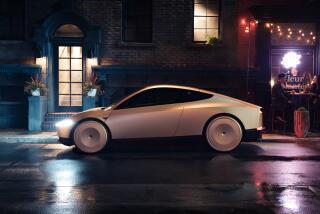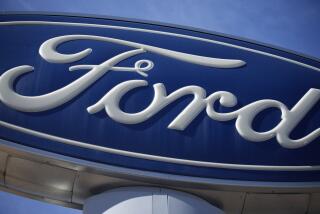Electric Car Still Needs Fine-Tuning : Automobiles: GM’s prototype is still just a prototype, but engineers point to progress made in two years.
MESA, Ariz. — General Motors Corp. is ready to go forward with full-scale commercial production of the Impact, its proposed electric passenger car, company engineers said Wednesday.
Except for some minor items, that is.
They need to improve the control system, lengthen the life of the battery, finish the marketing and production plans, announce a firm start date, set a price and probably change the car’s name.
Which is not to say that the much-ballyhooed clean-air car hasn’t progressed a long way since it was unveiled as a prototype in Los Angeles two years ago.
“We know what we have to do, and we’re proceeding with it,” said Bob Wragg, GM’s manager of electric vehicle market development for California, during a technical clinic for reporters at GM’s Desert Proving Ground outside Mesa.
After two years, there is still only one Impact, though GM has built several “mules”--standard vehicles converted to electricity and used to test the new propulsion systems.
On Wednesday, reporters test-driving the mules--including a converted Lumina APV van and a Geo Storm coupe--found them responsive and quick, accelerating like a gasoline-powered auto, but eerily silent.
GM did not allow test drives of the much-traveled Impact, however. It sat immobile on the nearby Tarmac, posing for photographers.
To be fair, the difficulties in taking any prototype and turning it into a production vehicle are enormous, and normal troubles are only compounded by the fact that the Impact is being designed from the ground up.
Though GM has developed an impressive electric car technology from scratch, the distance yet to be traveled was evident during technical briefings here Wednesday:
* GM will not say when it will begin production, other than a vague “mid-1990s”; California and other states will require sale of electric cars by 1998. The company has designated four plants to build parts of the car or assemble it, including a Hughes Aircraft plant in Torrance that will produce electronic controllers for the vehicle.
* Pricing and marketing decisions are still in the future. Among the unanswered questions: Will the car be sold as a Chevrolet, Buick, Pontiac or under another GM nameplate? Will it be priced to compete with sports cars, commuter cars, or upscale coupes?
* Even the name is unclear. “Impact” was conjured up at the last minute before the prototype’s unveiling, when a favored name was found to belong to someone else, Wragg said. Asked if the ultimate production car would bear the name Impact, he replied: “Almost certainly not.”
* In purely technical terms, the main challenge remains the battery, which GM has decided will be a variation of the traditional lead-acid ones found in most conventional autos.
The key limitations are range and life span, said John S. Dunning, a battery expert at GM’s Delco Remy Division. In addition, there are problems using several smaller batteries in series. “It’s like lining up elephants trunk to tail, then trying to make them start and stop together,” he said.
* Other technical challenges include refining the control system to involve fewer parts that can be easily and cheaply mass-produced; streamlining the car’s aerodynamics to reduce wind and tire resistance, and settling on a standard for battery recharging that can be built into homes and businesses.
None of the obstacles are “showstoppers,” said Larry Oswald, a member of GM’s advanced engineering staff. “We can do it. But we need to improve the car to a level that people are accustomed to in terms of fit and finish, quality and durability.”
Analysts express faith that GM can pull it off. “I think it is real,” said Christopher Cedergren, an industry analyst and senior vice president at the AutoPacific Group, a consulting firm in Thousand Oaks.
“I think they are trying to get it out for a 1995 or 1996 model year launch, possibly before that,” he said. “There are still some obstacles, but those obstacles are probably very workable. They could delay it, but not for long--possibly a year or 18 months.
“The thing they’re probably the most concerned about is retailing the vehicle out here: Who’s going to buy it? And the biggest concern is the price of the car.”
Gary L. Witzenberg, a GM manager of vehicle and test development, put it more simply: “It has to be a great car.”






